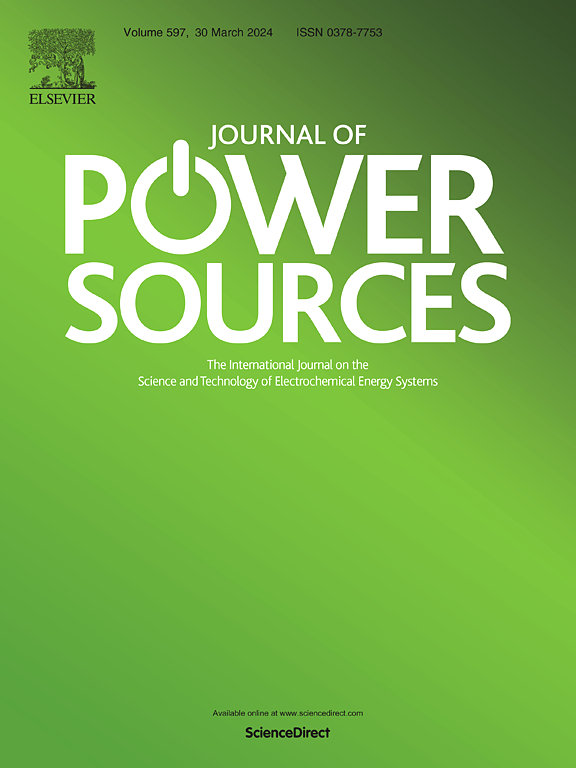铁辅助熔盐合成高石墨化分层多孔n掺杂碳增强水储能
IF 8.1
2区 工程技术
Q1 CHEMISTRY, PHYSICAL
引用次数: 0
摘要
开发具有高导电性和大比表面积的先进碳电极是电化学储能应用的关键。在这项工作中,我们提出了一种铁辅助熔盐(NaCl)策略来制造高度石墨化的分层多孔n掺杂碳(GHPNC),作为高性能超级电容器的有效电极。氯化铁(FeCl3)作为活化剂促进微介孔结构的形成,NaCl和生成的氧化铁促进大孔的形成。优化后的GHPNC-5.0-1.0样品(5.0表示fecl3与碳前驱体的质量比,1.0表示nacl与碳前驱体的质量比)具有发达的分层多孔结构和高石墨化,具有优异的电化学性能。在6 M KOH的电解液中,GHPNC-5.0-1.0电极在0.5 a g−1时的电容为201.5 F g−1。用该电极组装的对称超级电容器(SSC)在250.17 W kg - 1的功率密度下可提供9.84 Wh kg - 1的能量密度。在2 M ZnSO4电解液中,GHPNC-5.0-1.0//Zn混合超级电容器(ZHSC)在625 W kg -1时的能量密度为79.87 Wh kg -1。值得注意的是,ZHSC具有出色的循环稳定性,在10,000次循环后保持近100%的电容。本文章由计算机程序翻译,如有差异,请以英文原文为准。

Iron-assisted molten salt synthesis of highly graphitized hierarchical porous N-doped carbon for enhanced aqueous energy storage
The development of advanced carbon electrodes with high conductivity and a large specific surface area is crucial for electrochemical energy storage applications. In this work, we propose an iron-assisted molten salt (NaCl) strategy to fabricate highly graphitized hierarchical porous N-doped carbon (GHPNC) as an efficient electrode for high-performance supercapacitors. Ferric chloride (FeCl3) is employed as an activator to promote the formation of a micro-mesoporous structure, while NaCl and the resulting iron oxide facilitate the development of macropores. The optimized GHPNC-5.0-1.0 sample (where 5.0 represents the FeCl3-to-carbon precursor mass ratio and 1.0 denotes the NaCl-to-carbon precursor mass ratio) exhibits a well-developed hierarchical porous structure and high graphitization, leading to excellent electrochemical performance. In a 6 M KOH electrolyte, the GHPNC-5.0-1.0 electrode achieves a capacitance of 201.5 F g−1 at 0.5 A g−1. A symmetric supercapacitor (SSC) assembled with this electrode delivers an energy density of 9.84 Wh kg−1 at a power density of 250.17 W kg−1. In a 2 M ZnSO4 electrolyte, the GHPNC-5.0-1.0//Zn hybrid supercapacitor (ZHSC) demonstrates an energy density of 79.87 Wh kg−1 at 625 W kg−1. Notably, the ZHSC exhibits outstanding cycling stability, retaining nearly 100 % of its capacitance after 10,000 cycles.
求助全文
通过发布文献求助,成功后即可免费获取论文全文。
去求助
来源期刊

Journal of Power Sources
工程技术-电化学
CiteScore
16.40
自引率
6.50%
发文量
1249
审稿时长
36 days
期刊介绍:
The Journal of Power Sources is a publication catering to researchers and technologists interested in various aspects of the science, technology, and applications of electrochemical power sources. It covers original research and reviews on primary and secondary batteries, fuel cells, supercapacitors, and photo-electrochemical cells.
Topics considered include the research, development and applications of nanomaterials and novel componentry for these devices. Examples of applications of these electrochemical power sources include:
• Portable electronics
• Electric and Hybrid Electric Vehicles
• Uninterruptible Power Supply (UPS) systems
• Storage of renewable energy
• Satellites and deep space probes
• Boats and ships, drones and aircrafts
• Wearable energy storage systems
 求助内容:
求助内容: 应助结果提醒方式:
应助结果提醒方式:


